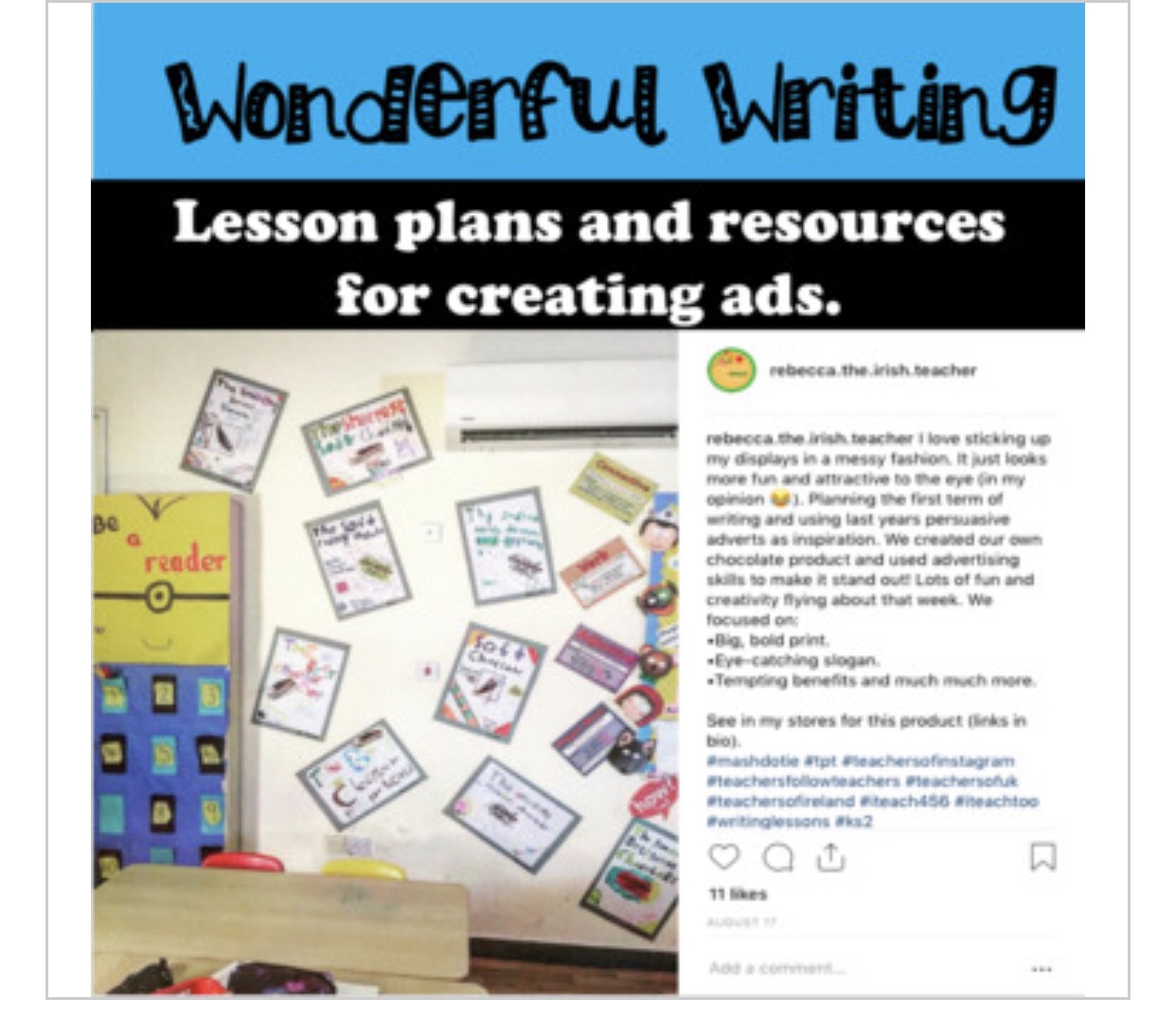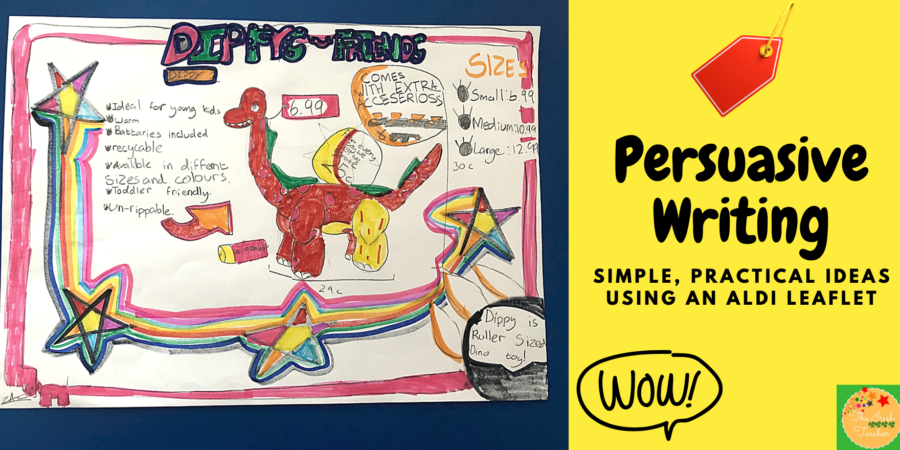For the last two weeks, we have engaged with the genre of persuasive writing. Personally, I find that since returning to school after distance learning, the children are not as enthusiastic about writing.
With that in mind, I wanted to motivate them to write, while covering persuasive writing at the same time. I decided to focus on persuasive adverts as it was a nice introduction to this genre and allowed for more creativity and fun in my opinion.
Links to The Book Depository are affiliate links.
Planning for Persuasive Writing
As always when I start a new genre, I took out my trusty copy of Talk for Writing to see if there were any key ideas that I could use to inform my planning.
Before I began planning, I then knew that I wanted children to reach these end goals after two weeks:
- Audience- to understand WHO their advertisement was for.
- Weasel words- to use persuasive adjectives and descriptions to persuade their reader.
- Author’s choice- to comment on the effect of shapes, colours and fonts used to persuade the reader and apply this when creating their own advertisement.
- Presentation- to think about how to make the key information stand out to their reader.
- Topic specific vocabulary- to ensure the children had the vocabulary needed to sell their product successfully.
Once decided on the end goals of this unit, I was able to plan my daily lessons accordingly.
Model Text
With each genre, it is so important to have a variety of texts for children to pick apart and take ideas from. While I normally take from my library, with this genre, I wanted children to get a sense of real-life purpose with their writing this week.
We physically cut apart and dissected an Aldi leaflet and took SO much inspiration from it. What better than a real-life example of persuasive writing in action. But also- NO PREP!
They are free in all Aldi stores and FULL of useful lessons (Maths too).
 Image taken from the Aldi website.
Image taken from the Aldi website.Setting children up for success to write a persuasive advertisement
Below I’ll list some activities which we did in order to build the children up to write a successful persuasive advertisement.
Gauge their understanding of oral persuasion
I modelled how to persuade the children to do their Maths work. I showed them how to use flattery (but not too much) and inform them of how it would be a good choice FOR THEM. We had to have lots of discussions about how and why threats can’t be used too.
Then, I wrote 25 topics on lollipop sticks and asked children to practise persuading the others on their table, using a similar technique. This was a good way for me to assess where children needed help with persuasive writing in the coming weeks.
![]()

Highlight “weasel words” in the Aldi leaflet
In mixed ability pairs, allow children to use a highlighter or marker to underline the words that would catch the reader’s eye. For example: quick absorbing and enriched with anti-oxidants.
Allow them to make a list in their copies to refer back to. Not all weasel words will be relevant to their product, but they will be able to choose themselves when it comes to that.

Sort positive and negative adjectives
This was done as a starter for a lesson. Children worked in pairs to discuss and decided which adjective went into which category. This increased their awareness of the importance of choosing the correct adjective and the impact that it would have on their product’s sales.

Turn a “negative” paragraph into a “positive” paragraph
Display the “negative” paragraph on the board and highlight all of the adjectives that make this paragraph sound negative and unappealing. As a class, make a list of appropriate words that could replace them to make this paragraph much more appealing and persuasive.
End this lesson by discussing the importance of choosing effective adjectives and descriptions for a product.

Create a sample, “super” advert
This lesson was very effective and useful to build on prior to the children’s writing of their own advertisement.
Children were asked to create an advertisement for a toy dinosaur in pairs on sugar paper. They could cut out any “weasel words” or price tags from the Aldi leaflet that they felt stood out.
This really made for great discussion on which price tags or slogans caught their eye and why. It also led to a discussion on how many eye-catching phrases were too much, as it would overwhelm the reader.
Bullet points were collectively chosen too to portray the information, as shoppers don’t have time to read paragraphs of information. They want it quickly and clearly.
![]()

Create a list of “weasel words” that could be used for our product
As mentioned before, we were building up to create an advertisement for a dinosaur toy. We were covering dinosaurs in guided reading, so I figured it made sense to link the two. Make the product relevant to the children. They then flicked through the Aldi leaflet again, with a different hat on this time. They picked out “weasel words” that could be used to sell a dinosaur toy and jotted them down for reference later in the week.
Words such as:
- Toddler friendly
- Made from recyclable material
- Batteries included
- Unrippable
These were words that children discussed in pairs and decided whether or not it was relevant to their toy. It was amazing to see them take ownership of their work and not rely on a list that I could have (but didn’t) provided for them.
These activities took place over the course of two weeks. By this point, I felt that my class were ready to create their own advertisement.
I gave them an A4 page each, their “super sample” that they made earlier in the week and displayed this criteria on the board. Nothing fancy at all, but it was super effective.
Must Have
- Product Name
- Image
- Description (Bullet Points)
- Price
- 1 or 2 persuasive phrases.
Think about
- Colours
- Shapes
- Font
- Layout
If you look closely to the images below, you will notice that the children chose to use dinosaur footprints instead of bullet points, to catch the readers eye.
They really thought carefully about their designs, sizes, shapes and fonts.
They chose their words carefully and effectively and I couldn’t be more proud of them on the end results.
End Product
Resources for Persuasive Writing– in the past with 3rd Class/Year 4 pupils, I made use of this resource and it worked wonders.
 https://www.teacherspayteachers.com/Product/Persuasive-Writing-Unit-3701058
https://www.teacherspayteachers.com/Product/Persuasive-Writing-Unit-3701058
However, I felt like delving into this topic a little differently this year. Feel free to screenshot and use anything I’ve mentioned above and tag me on Instagram if you’d like too. I love seeing people using my ideas.
For a simple poetry lesson idea, click here.
For ways to promote a love of reading in the class, click here.
I hope this was helpful.

